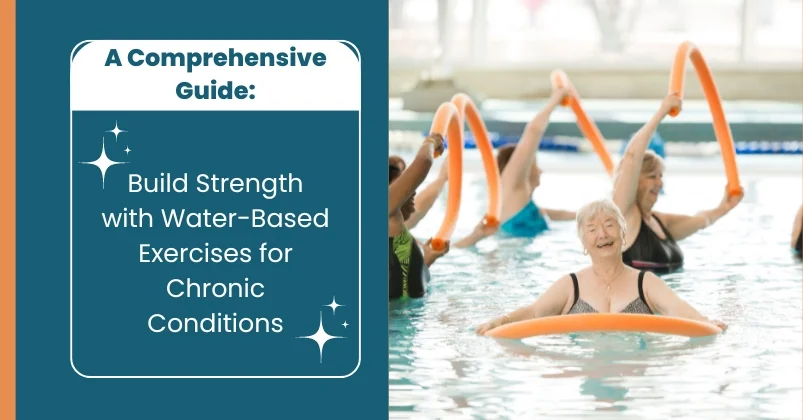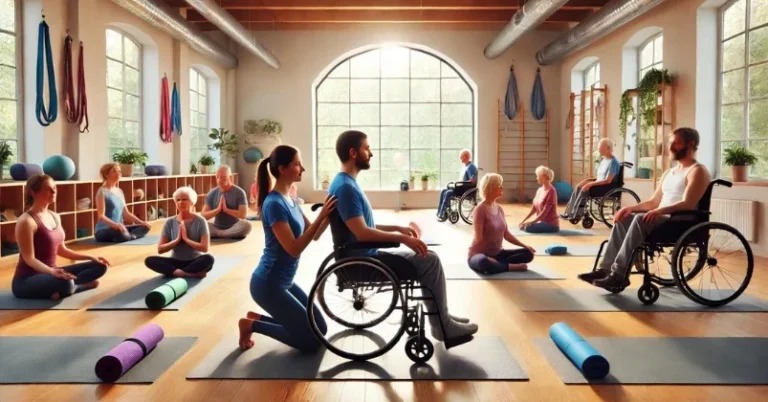Build Strength with Water-Based Exercises for Chronic Conditions: A Comprehensive Guide
Water-based exercises are an excellent way to build strength and improve overall fitness, especially for individuals with chronic conditions. These exercises provide a low-impact option for those who may have difficulty with traditional land-based exercises due to joint pain, limited mobility, or other health concerns. Water-based exercises can be done in a pool, hot tub, or even a bathtub, making them accessible to a wide range of individuals.
Research has shown that water-based exercises can have numerous benefits for individuals with chronic conditions such as arthritis, fibromyalgia, and multiple sclerosis. These exercises can help to reduce pain and stiffness, improve flexibility and range of motion, and increase muscle strength and endurance. Additionally, water-based exercises can be a great way to improve cardiovascular health, reduce stress, and boost overall mood and well-being.
Whether you are looking to start a new exercise routine or are simply looking for a low-impact way to stay active, water-based exercises can be a great option. With a variety of exercises to choose from and the added benefits of water resistance and buoyancy, these exercises can help you build strength, improve your overall fitness, and manage chronic conditions.
Understanding Water-Based Exercises
Water-based exercises are a form of physical activity that involves performing exercises in a pool or other body of water. This type of exercise is ideal for individuals with chronic conditions such as chronic obstructive pulmonary disease (COPD), arthritis, or multiple sclerosis, as it provides a low-impact, full-body workout that can help improve strength, flexibility, and overall fitness.
Water-based exercises are typically performed in a shallow pool, with the water level reaching no higher than the chest. The exercises are designed to be low-impact, meaning that they place minimal stress on the joints and muscles. This makes them ideal for individuals who may have difficulty performing land-based exercises due to joint pain or other physical limitations.
Some of the benefits of water-based exercises include improved cardiovascular health, increased strength and endurance, and reduced stress on the joints. Additionally, water-based exercises can help improve balance and coordination, which can be especially beneficial for individuals with neurological conditions such as Parkinson's disease.
Water-based exercises can be performed individually or as part of a group class. Many fitness centers and community centers offer water-based exercise classes that are designed specifically for individuals with chronic conditions. These classes are typically led by a trained instructor who can provide guidance and support throughout the workout.
In summary, water-based exercises are a low-impact, full-body workout that can help improve strength, flexibility, and overall fitness. They are ideal for individuals with chronic conditions who may have difficulty performing land-based exercises and can be performed individually or as part of a group class. The benefits of water-based exercises include improved cardiovascular health, increased strength and endurance, and reduced stress on the joints.
Benefits of Water-Based Exercises for Chronic Conditions
Water-based exercises can be an excellent option for people with chronic conditions such as arthritis, diabetes, heart disease, osteoporosis, stroke, depression, back pain, asthma, cancer, dementia, anxiety, COPD, type 2 diabetes, and fibromyalgia.
One of the primary benefits of water-based exercises is that they are low-impact and gentle on joints, making them an ideal option for people with arthritis or other joint-related conditions. The natural resistance of water also helps to strengthen muscles, improve flexibility, and increase range of motion.
Research has shown that water-based exercises can have a positive impact on overall health and quality of life. For example, a systematic review with meta-analysis found that water-based training programs can improve physical fitness and health status in healthy adults and adults with chronic diseases, making it a great option for those looking to improve their overall health.
Additionally, water-based exercises can be an effective way to improve heart health. The Mayo Clinic notes that exercising in water can help reduce stress, improve muscular endurance and strength, and improve cardiovascular health.
Overall, water-based exercises offer a variety of health benefits for people with chronic conditions. Whether you're looking to improve joint health, increase muscle strength, or improve overall health and quality of life, water-based exercises are a great option to consider.
The Science Behind Water-Based Exercises
Water-based exercises are effective strategies for building strength, improving cardio fitness, and reducing the risk of chronic diseases such as heart disease, diabetes, and even cancer. But what makes water-based exercises so effective, and how do they work?
Buoyancy
One of the key benefits of water-based exercises is buoyancy. When you are in the water, your body is buoyed up, which reduces the impact on your joints and makes it easier to move around. This is especially beneficial for people with chronic conditions such as arthritis or back pain, who may find it difficult to exercise on land.
Hydrostatic Pressure
Another important factor is hydrostatic pressure. When you are in the water, the pressure of the water against your body can help to reduce swelling and inflammation, which can be especially helpful for people with conditions such as lymphedema or chronic venous insufficiency.
Resistance
Water also provides resistance, which can help to build strength and improve muscle tone. This resistance is proportional to the speed and force of your movements, which means that you can adjust the intensity of your workout based on your fitness level and goals.
Heat
The temperature of the water can also play a role in the effectiveness of water-based exercises. Warm water can help to relax muscles and increase blood flow, which can be beneficial for people with conditions such as fibromyalgia or chronic pain.
Support
Finally, water-based exercises can provide support for people with mobility issues or balance problems. The water can help to stabilize your body and reduce the risk of falls or injuries.
In summary, water-based exercises offer a range of benefits for people with chronic conditions. The buoyancy, hydrostatic pressure, resistance, heat, and support provided by the water can all contribute to improved strength, fitness, and overall health.
Building Strength with Water-Based Exercises
Water-based exercises are an excellent way to build strength, particularly for individuals with chronic conditions. These exercises offer a low-impact alternative to traditional strength training, making them an ideal option for those with joint pain or limited mobility.
Water-based exercises can help improve muscle strength, endurance, and flexibility. They are also an effective way to increase cardiovascular fitness, which is important for overall health.
To build strength with water-based exercises, consider incorporating resistance gloves, dumbbells, foam dumbbells, or ankle weights into your routine. These tools can help add resistance to your movements, making them more challenging and effective.
When performing water-based exercises, it's important to focus on proper form and technique. This will help ensure that you are targeting the right muscle groups and getting the most out of your workout.
Some effective water-based exercises for building strength include:
- Water walking or jogging: Walk or jog back and forth across the pool, focusing on pushing against the resistance of the water.
- Water aerobics: Participate in a water aerobics class, which typically involves a variety of exercises designed to improve strength, flexibility, and cardiovascular fitness.
- Swimming: Swim laps or perform different strokes to target different muscle groups.
Overall, water-based exercises are a safe and effective way to build strength and improve overall health, particularly for individuals with chronic conditions. Incorporating resistance tools and focusing on the proper form can help maximize the benefits of these exercises.
Improving Flexibility and Balance with Water-Based Exercises
Water-based exercises can be an effective way to improve flexibility and balance, especially for individuals with chronic conditions. The buoyancy of water helps to reduce the impact on joints, making it easier to move and stretch without causing pain or stiffness. Additionally, the resistance of water can help to build strength and improve coordination.
Flexibility exercises in water can be particularly helpful for individuals with conditions like arthritis, which can cause stiffness and limited range of motion. Water-based exercises like water walking, leg swings, and arm circles can help to loosen up joints and improve flexibility. These exercises can be done in shallow water and can be modified to accommodate different fitness levels and abilities.
Balance exercises in water can also be beneficial for individuals with chronic conditions, as water provides a safe and stable environment to practice balance and coordination. Exercises like standing on one leg, heel-to-toe walking, and leg lifts can help to improve balance and reduce the risk of falls. These exercises can be done in shallow water or with the support of a flotation device.
In addition to improving flexibility and balance, water-based exercises can also help to reduce joint pain and stiffness. The warmth of the water can help to relax muscles and increase blood flow, which can help to alleviate pain and inflammation. Additionally, the low-impact nature of water-based exercises can help to reduce the strain on joints and prevent further damage.
Overall, water-based exercises can be a valuable tool for individuals with chronic conditions looking to improve flexibility, balance, and joint health. By incorporating these exercises into a regular fitness routine, individuals can experience the benefits of water-based exercise and improve their overall quality of life.
Water-Based Exercises for Different Body Parts
Water-based exercises are an excellent way to build strength and endurance, especially for those with chronic conditions. Here are some exercises that target different body parts:
Lower Body
- Lunges: Stand in shoulder-deep water, with your feet hip-width apart. Take a step forward with your right foot and bend your knees, lowering your body until your right thigh is parallel to the pool floor. Return to the starting position and repeat with your left leg.
- Forward Lunges: Stand in shoulder-deep water, with your feet hip-width apart. Take a step forward with your right foot and bend both knees, lowering your body until your right thigh is parallel to the pool floor. Return to the starting position and repeat with your left leg.
- Jumping Jacks: Stand in chest-deep water, with your feet together and arms at your sides. In an arc motion, bring your arms overhead as you jump your legs apart. Land with your feet shoulder-width apart and your arms extended to the sides. Jump back to the starting position and repeat.
Upper Body
- Arm Raises: Stand in shoulder-deep water with your arms at your sides. Raise your arms to the sides until they are shoulder height, then lower them back down.
- Arm Circles: Stand in shoulder-deep water with your arms extended to the sides. Make small circles with your arms, gradually increasing the size of the circles.
- Forearm Exercises: Stand in shoulder-deep water with your arms extended in front of you. Make fists with your hands and rotate your wrists in a circular motion.
Full Body
- Squats: Stand in shoulder-deep water, with your feet hip-width apart. Lower your body until your thighs are parallel to the pool floor, then return to the starting position.
- Jumping Jacks: Stand in chest-deep water, with your feet together and arms at your sides. In an arc motion, bring your arms overhead as you jump your legs apart. Land with your feet shoulder-width apart and your arms extended to the sides. Jump back to the starting position and repeat.
These exercises target various muscle groups and can help build strength and endurance. Incorporating water-based exercises into your workout routine can be an effective way to improve your overall health and well-being.
Special Considerations for Water-Based Exercises
When it comes to water-based exercises, certain considerations need to be taken into account, especially for those with chronic conditions. Here are some special considerations to keep in mind:
Buoyancy Belt
A buoyancy belt can be a useful piece of equipment for those with chronic conditions such as arthritis or joint pain. This belt can provide support and help to reduce the impact on the joints during exercises, making it easier to perform certain movements.
Equipment
When performing water-based exercises, it's important to use equipment that is appropriate for your condition. For example, if you have arthritis in your hands, you may want to use gloves with paddles to help with grip and reduce the strain on your joints.
Water Walking
Water walking is a low-impact exercise that can be beneficial for those with chronic conditions. Walking in water can help to reduce the impact on the joints and can be a great way to improve cardiovascular fitness.
Walking in Chest-Deep Water
Walking in chest-deep water is another low-impact exercise that can be beneficial for those with chronic conditions. This exercise can help to improve balance, strength, and cardiovascular fitness. It's important to start slowly and gradually increase the intensity of the exercise.
Joints Affected by Arthritis
If you have arthritis, it's important to be careful when performing water-based exercises. You should avoid exercises that put a lot of stress on your joints, such as jumping or running. Instead, focus on low-impact exercises such as water walking or swimming.
Swelling
If you have swelling in your legs or feet, it's important to be cautious when performing water-based exercises. You should avoid exercises that involve jumping or running, as these can increase swelling. Instead, focus on exercises that involve gentle movements such as water walking or swimming.
Falls
Falls can be a concern for those with chronic conditions, especially in the water. It's important to take precautions to reduce the risk of falls, such as using a buoyancy belt or holding onto the edge of the pool. It's also important to start slowly and gradually increase the intensity of the exercise to reduce the risk of falls.
Role of Physical Therapists in Water-Based Exercises
Physical therapists play a critical role in designing safe and effective water-based exercise programs for individuals with chronic conditions. They work with patients to develop individualized exercise plans that address their unique needs, taking into account their medical history, physical limitations, and fitness goals.
One of the key benefits of working with a physical therapist is that they can help patients learn the proper form and technique for each exercise, reducing the risk of injury. They can also guide how to adjust the intensity and duration of exercises to fit the patient's abilities and progress.
For individuals with chronic respiratory conditions, such as chronic obstructive pulmonary disease (COPD), physical therapists can also incorporate pulmonary rehabilitation techniques into water-based exercise programs. These techniques can help improve lung function, reduce shortness of breath, and increase exercise tolerance.
In addition to working directly with patients, physical therapists can also provide support and guidance to caregivers and family members. They can teach them how to assist with exercises and provide tips for promoting safety and independence during water-based exercise sessions.
Overall, physical therapists are an essential part of any water-based exercise program for individuals with chronic conditions. They bring a wealth of knowledge and expertise to the table, helping patients achieve their fitness goals while minimizing the risk of injury.
Water-Based Exercises for Special Populations
Water-based exercises are a great option for people with chronic conditions, as they are low-impact and gentle on the joints. Additionally, they can be easily adapted to meet the needs of special populations, such as pregnant women and seniors.
Pregnant Women
Water-based exercises are an excellent way for pregnant women to stay active and healthy throughout their pregnancy. The buoyancy of the water helps to relieve pressure on the joints, making water-based exercises a low-impact option that is gentle on the body.
Some great water-based exercises for pregnant women include:
- Water walking: Walking in waist-high water is a great way to get a cardiovascular workout without putting too much strain on the joints.
- Swimming: Swimming is a full-body workout that can help to improve cardiovascular fitness, increase muscle strength, and reduce stress.
- Aqua aerobics: Aqua aerobics classes are a fun way to get a workout in a supportive environment. Classes are typically led by a certified instructor who can provide modifications for pregnant women.
Pregnant women need to check with their healthcare provider before starting any new exercise program.
Seniors
Water-based exercises are an ideal option for seniors, as they provide a low-impact workout that can help to improve cardiovascular fitness, increase muscle strength, and reduce the risk of falls.
Some great water-based exercises for seniors include:
- Water walking: Walking in waist-high water is a great way to get a cardiovascular workout without putting too much strain on the joints.
- Aqua aerobics: Aqua aerobics classes are a fun way to get a workout in a supportive environment. Classes are typically led by a certified instructor who can provide modifications for seniors.
- Water resistance training: Water resistance training is a great way to build muscle strength. Exercises can be done with or without equipment, such as water dumbbells or resistance bands.
It's important for seniors to check with their healthcare provider before starting any new exercise program, and to work with a certified instructor who can provide modifications as needed.
FAQs
Water aerobics can help improve balance and coordination by providing a low-impact environment where individuals can move more freely without the risk of falling. The buoyancy of the water reduces the impact on the joints, allowing for a wider range of motion and greater stability. Additionally, the resistance of the water can help strengthen muscles and improve overall body control.
Water aerobics is a great option for overweight individuals because it is a low-impact form of exercise that can help reduce stress on the joints. The buoyancy of the water also helps to support the body, making it easier to move and exercise. Water aerobics can also help improve cardiovascular health and promote weight loss.
Yes, water-based exercises can be very helpful for those with chronic diseases. According to the National Institute on Aging, exercise can help manage chronic conditions such as arthritis, back pain, obesity, heart disease, depression, and diabetes. Water-based exercises can provide a low-impact option for individuals with chronic conditions, allowing them to exercise without exacerbating their symptoms.
Water aerobics exercises that can help seniors include water walking, water jogging, water aerobics classes, and swimming laps. These exercises can help improve cardiovascular health, strengthen muscles, and improve overall mobility.
Yes, water aerobics is a suitable physical activity for all ages. Water aerobics provides a low-impact form of exercise that can be adjusted to meet the needs of individuals of all ages and fitness levels. Additionally, the buoyancy of the water can help reduce the risk of injury, making it a safe option for individuals who may be at risk for falls or other injuries.
Aquatic exercise can provide many benefits for individuals with Parkinson's disease. According to the Parkinson's Foundation, aquatic exercise can help improve balance, reduce stiffness and rigidity, and improve overall mobility. Additionally, the buoyancy of the water can help reduce the risk of falls and provide a safe environment for individuals with Parkinson's disease to exercise.








